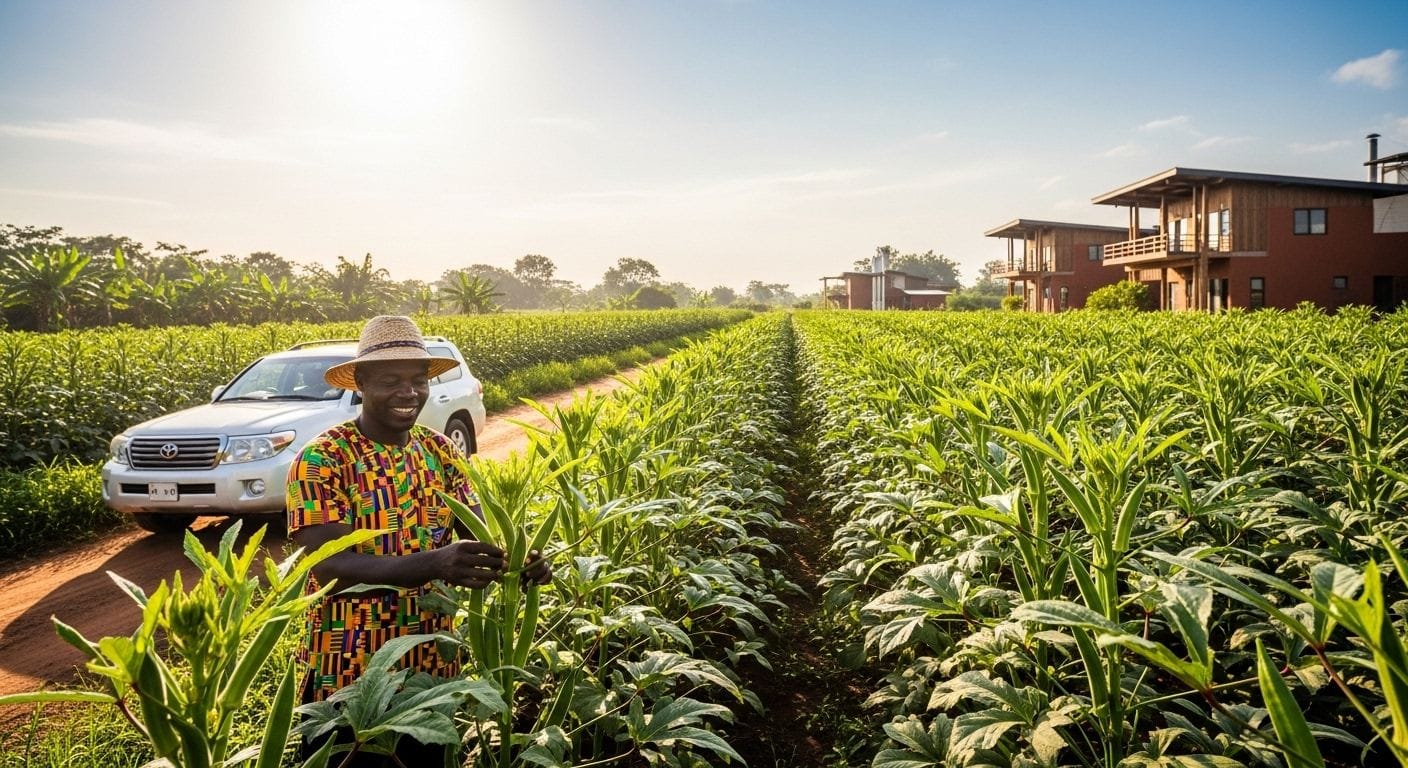How to Start a Profitable Okra Farm in Ghana: Your Complete Guide
Okra, known locally as Okro, is a staple vegetable in Ghana, prized for its nutritional value and integral role in many local dishes. Beyond the kitchen, it represents a significant economic opportunity. With high demand in both domestic and international markets, successful okra cultivation in Ghana can be a highly profitable venture for savvy entrepreneurs. This comprehensive guide provides a step-by-step process, from seed to sale, to help you establish and run a thriving okra farm.
Why Start an Okra Farming Business in Ghana?
Embarking on an okra farming journey in Ghana offers several compelling advantages, making it an attractive venture for entrepreneurs:
- High Profitability: Okra has a short growth cycle and can be harvested multiple times, leading to a steady income stream. With strong market demand, it can be a profitable venture for entrepreneurs, with some reports indicating potential weekly earnings of over GHS 6,000 from a single acre during peak season.
- Strong Market Demand: There is a consistent demand for fresh okra in local Ghanaian markets. Furthermore, Ghana is a major exporter of okra to Europe and North America, opening up lucrative international market opportunities.
- Nutritional and Health Benefits: Okra is rich in fiber, vitamins A and C, and essential minerals. It’s known to aid digestion, boost immunity, and promote healthy skin, making it a valuable crop for community nutrition.
- Environmental Benefits: Okra plants are known to improve soil health by fixing nitrogen. They are also relatively drought-tolerant, making them suitable for cultivation in regions with variable water resources.
Step 1: Pre-Planting Essentials – Laying the Groundwork
Proper planning and preparation are critical for success. Before you plant a single seed, you must ensure the conditions are perfect for your crop.
Climate and Soil Requirements
Okra is a warm-season crop that thrives in Ghana’s tropical climate. For optimal growth, it requires:
- Temperature: A consistent temperature range between 25°C and 35°C.
- Soil Type: Well-drained, rich loamy or sandy soils are ideal. Avoid soils that are prone to waterlogging.
- Soil pH: A slightly acidic to neutral pH level of 6.0 to 6.8 is recommended. A soil test can help you determine your soil’s pH and nutrient levels.
Selecting the Right Okra Varieties
Choosing the right seed variety is a crucial decision that impacts your yield, disease resistance, and marketability. Always buy certified seeds from reputable suppliers. Popular and recommended varieties in Ghana include:
- Asutem
- Lady’s Finger
- Clemson Spineless
- Quim Bombo
- Labadi Dwarf
- Annie Oakley (Hybrid)
Consider your target market when selecting a variety. Buyers for the fresh market often prefer star-shaped pods, while some processors and soup manufacturers prefer round-podded types like Emerald.
Land Preparation
Prepare your field thoroughly to create an ideal environment for your okra plants.
- Clear the Land: Remove all weeds, trees, rocks, and root stumps from the selected site.
- Plough and Harrow: Till the soil to a depth of 20-25 cm (8-10 inches). This loosens the soil, improves aeration, and enhances water infiltration. Break down any large soil clods to create a fine tilth.
- Incorporate Organic Matter: Add well-decomposed manure or compost (around 20 metric tonnes per hectare) to the soil. This enriches the soil with essential nutrients and improves its texture and moisture-holding capacity.
- Create Ridges: Prepare ridges or furrows spaced approximately 60-90 cm apart. This helps with drainage and irrigation.
Step 2: Planting and Nurturing Your Okra Crop
With the land prepared, you are ready to plant. Follow these steps for healthy growth and a bountiful harvest.
Sowing the Seeds
- Seed Preparation: For better germination, soak the okra seeds in water for up to 24 hours before planting.
- Sowing: Plant seeds directly into the moist soil at a depth of 2-5 cm. Plant 4-6 seeds per foot.
- Spacing: Maintain a spacing of 60-90 cm between rows and 20-40 cm between plants within the rows.
- Thinning: After the seeds have germinated and seedlings are established, thin them out to leave one healthy plant per stand.
- Watering: Water the seeds immediately after sowing and keep the soil consistently moist (but not waterlogged) to ensure good germination.
Irrigation and Water Management
Consistent moisture is vital for okra, especially during the flowering and pod development stages. While okra can tolerate some dry periods, regular watering ensures maximum yield. Drip irrigation is a highly efficient method as it delivers water directly to the plant’s root zone, minimizing water waste and reducing the risk of foliar diseases.
Fertilizer Application
A soil test is the best way to determine your specific fertilizer needs. However, a general recommendation is as follows:
- At Planting: Apply a balanced fertilizer like NPK 15-15-15 at a rate of 220 kg per hectare.
- During Flowering: Side-dress the plants with a nitrogen-rich fertilizer to promote vigorous growth and fruiting. Apply 110-150 kg/ha of Sulphate of Ammonia or 75 kg/ha of Urea. This can be done in two or three split applications once the plants are about 30 cm tall.
Pest and Disease Control
Proactive management is key to protecting your crop.
- Common Pests: Be vigilant for pests like Aphids, Whiteflies, Bollworms, Jassids, and Root-knot nematodes.
- Common Diseases: Watch out for diseases such as Powdery Mildew, Leaf Curl, and Mosaic virus.
- Control Methods: Employ Integrated Pest Management (IPM) practices. This includes crop rotation (avoid planting after crops like squash or sweet potatoes, which increase nematode populations), using resistant varieties, and regular monitoring. For control, consider using Neem seed extract or other EPA-approved pesticides, always following manufacturer guidelines. Control vectors like aphids and whiteflies to prevent the spread of viral diseases.
Step 3: Harvesting and Post-Harvest Handling
The final stages are just as important as the initial ones for ensuring a high-quality, profitable product.
Harvesting Your Okra
Okra pods are typically ready for harvest about 50-60 days after sowing. The key is to harvest them at the right time.
- When to Harvest: Pick the pods when they are young and tender, usually 5-6 days after the flower opens. As a test, the tip of the pod should snap off easily.
- How to Harvest: Use a sharp knife or pruning shears to cut the pods from the plant. Wear cotton gloves to minimize bruising.
- Frequency: Harvest every 2-3 days. Regular and frequent picking is crucial as it encourages the plant to produce more pods, significantly increasing your overall yield. Leaving mature pods on the plant will reduce future production.
Post-Harvest Handling and Storage
Handle harvested okra with care to maintain its quality and shelf life.
- Handling: Avoid bruising the pods, as damaged spots will turn black within hours. Place them carefully in ventilated crates or baskets.
- Storage: Okra is perishable. Store it in a cool place at a temperature between 7-10°C to prolong its freshness.
- Grading: For fresh market sales, sort and grade the pods by size. Common grades include ‘Fancy’ (up to 3.5 inches), ‘Choice’ (3.5 to 4.5 inches), and ‘Jumbo’ (over 4.5 inches but still tender).
Step 4: Marketing and Profitability Analysis
A solid marketing plan ensures your hard work translates into profit.
Marketing Your Produce
- Local Markets: Sell directly to consumers, retailers, restaurants, and wholesalers in local markets. Ensure your produce is clean and well-packaged to attract buyers.
- Export Markets: For larger-scale operations, explore the export market. Work with export companies or farmer cooperatives to access international markets in Europe and North America, but be prepared to meet stringent quality and packaging standards. Okra for export is typically packed in 6kg boxes.
Sample Profitability Budget (Per Hectare)
The following is an estimated budget to illustrate the potential profitability. Costs and prices can vary based on location, season, and management practices.
| Activity | Estimated Cost (GHS) |
|---|---|
| Land Rent | 250.00 |
| Land Preparation | 400.00 |
| Seeds | 600.00 |
| Fertilizer & Manure | 2,312.00 |
| Pesticides | 100.00 |
| Labour | 2,500.00 |
| Total Estimated Cost | 6,162.00 |
Revenue Projection
- Average Yield per Hectare: 12 tonnes (12,000 kg)
- Marketable Yield (after 5% loss): 11,400 kg
- Packaging (in 6 kg boxes): 1,900 boxes
- Farm Gate Price per 6 kg box: GHS 8.00 (Note: This is a conservative estimate; prices can be much higher)
- Total Income: 1,900 boxes * GHS 8.00 = GHS 15,200.00
- Estimated Net Income: GHS 15,200.00 – GHS 6,162.00 = GHS 9,038.00
Disclaimer: This budget is an estimate and does not include fixed costs or overheads. Market prices fluctuate significantly.
Conclusion
Starting a profitable Okro farm in Ghana is a highly achievable goal for any dedicated entrepreneur. By selecting the right variety, preparing your land diligently, nurturing your crop with proper irrigation and nutrients, and harvesting at the optimal time, you can build a successful and sustainable agribusiness. With both strong local demand and lucrative export potential, okra farming stands out as a golden opportunity in Ghana’s agricultural sector.











